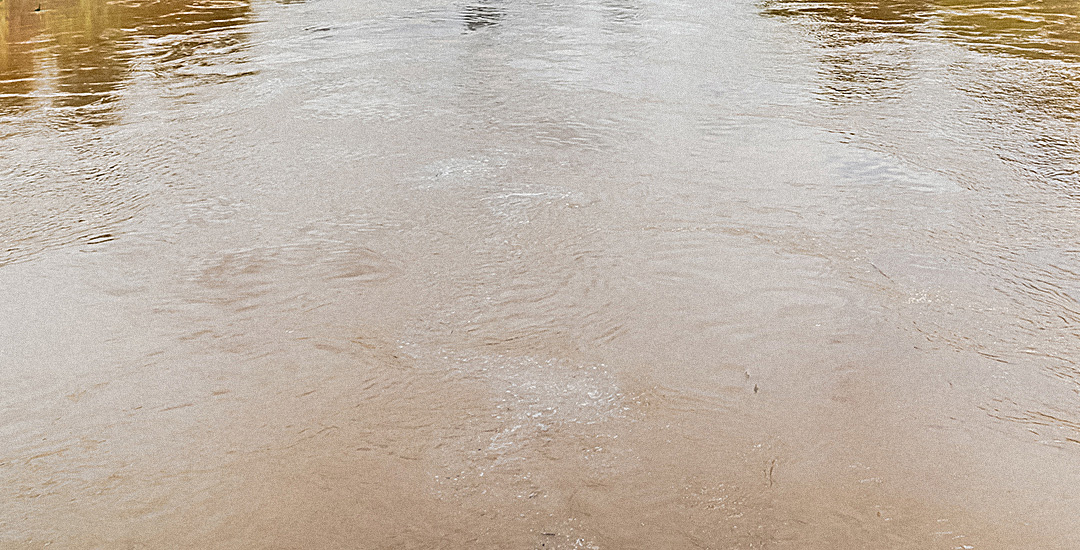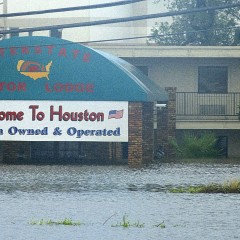Writer and professor Lacy M. Johnson founded the Houston Flood Museum to help collect these stories while the city began its lumbering recovery. A new book, “More City than Water: A Houston Flood Atlas,” serves as a culmination of the museum’s work, bringing together stories representing a slice of the city. It asks the reader to revisit the disaster and to confront some of the deeper questions that surfaced in its wake.
The Urban Edge invited Johnson and her collaborator, UH design professor Cheryl Beckett, to discuss the book, its lessons and its impact. (You can also hear from Johnson and others in a remembrance event on Aug. 26.)
This book weaves together history, poetry, art, interviews and essays. What guided you as you looked for voices to include?
Johnson: I wanted to bring together people who had different perspectives on different parts of the city — Houston is such a vast geographic region — who brought different skills and tools and experiences to the work of thinking through these issues, and whose thinking could help clarify my own.
The work is a natural extension of your work with the Houston Flood Museum. What did that project do, and what does the book do that project could not?
Johnson: The Houston Flood Museum is primarily a work of public and communal remembering about flooding, and began with a coalition of various story-collecting efforts. We focused first on collecting stories based on our understanding of the work that stories can do to help us make sense of traumatic and catastrophic events. Even before the storm made landfall in Rockport on August 25, 2017, and ever since, stories have been circulating about the storm, about the flood, about the city and its heroes and its flaws. In our first five years, the Houston Flood Museum has worked to collect and preserve these stories, and part of this work has meant to ask what we remember and why and how, and in what ways we can learn from the past to move into the future.
The self-stated mission of the Houston Flood Museum is to exhibit the connections between human activity and catastrophic flooding — especially as linked to wealth inequality and racial disparity — and to act as a catalyst for reimagining the ways Houston, the Gulf Coast, and the wider world evolve in a context of persistent natural disasters. The atlas is an expression of this mission.
The book calls itself a “flood atlas,” and maps are a running design motif—not scientific plots of flooding or damage, but rather, interpretations of place and relationships between them. What was the significance of this choice? What process went into the design?
Beckett: Prior to making landfall, we are glued to hurricane tracking maps. We watch Houston mapped in relation to the Gulf—the size and trajectory of the storm inching its way towards us. So, the map is a powerful tool for discussing Harvey issues. The maps in "More City Than Water" on the one hand move in closer—to the neighborhoods and communities affected by the storm — and in other instances move further away— to express how the effects of climate change on a more global scale affects Houston.
As to the process, the author’s content propelled the maps, with the students searching for ways to express and encapsulate ideas: lack of resources are emphasized in Climate Dignity through a dramatic color break. Personal losses are portrayed through a map within a destroyed polaroid frame in "The Only Thing You Have." Our tenuous juxtaposition with industry during a storm is articulated via toxic circles encompassing neighborhoods in "We All Breathe the Same Air."
An overall visual language using watercolor textures that float and seep across the pages and through streets and neighborhoods reinforces the effects of water on Houston. This visual tool also helped the 26 University of Houston Graphic Design students maintain an aesthetic consistency.
Johnson: It’s also important to note, I think, that these maps were designed by students — the 2019 class graduating from the graphic design program at UH. In some cases, we had essays that were already finished, and those were pretty easy for the students to work with; but in the cases where we commissioned new essays, we asked the writers to send in abstracts of what they planned to write about, to get the design process going, and as the drafts of those essays came in, we shared them with the designers. But in all cases, the designers, working in teams, picked up on an element in the text and made their own visual interpretation of that — some of which were informational or representational, some of which articulated an argument in conversation with the essay. I began visiting the class in January — coming every few weeks, I think — and we worked together through May, when the maps were displayed at the Senior Design Show. At that time, we began a second process of editing the maps with a smaller team of designers from the class — six of the original group — and together we agreed on a “visual system”: all maps would use the same font, for instance; they would all have the tick marks on the side to suggest the flood gauge; all would use the compass rose in some form, and so forth. Meanwhile, I was working with many of the contributors to edit their pieces. Some came in nearly finished, but many of the contributors aren’t professional writers, and for some of these folks the editing process took the better part of a year. The team of six designers worked all summer; then a team of four continued to work on maps that continued to be what we were calling “visual outliers,” and then a team of two — Kristen Fernandez and Julia Ong — continued to work on the designs, and even made a few additional maps.
Everyone in the Houston area has a Harvey story, some more traumatic than others. With the perspective of bringing all these stories together and with the perspective of five years, what did you learn?
Johnson: I wrote about this at length in the Houston Chronicle last Sunday. Over the course of working on this book and on the Houston Flood Museum for the past five years, I’ve learned a lot about flooding in this city: I’ve learned it isn’t new, it isn’t neutral, and at this point in our history, we can no longer call it an accident. When I say, it’s not new, I mean: Houston has flooded at least 50 times since its founding — at least 16 floods in the first 100 years, and 34 floods in the 86 years since. It’s also not neutral, because flooding has not been distributed equally across the city. Because of outdated and unjust criteria that evaluate flood mitigation projects based on the total monetary value of the property protected, not on the number of people protected — criteria that date back to the Flood Control Act of 1936 — wealthy neighborhoods almost always qualify for flood mitigation projects, and poorer neighborhoods almost never do. The result, over time, is catastrophic inequality: wealth means people have the privilege to live in places where it does not flood, and poverty means people can’t afford to live where it doesn’t. And I say we can’t call it an accident because this city is built on land that was once coastal prairie and wetlands, and to talk about flooding in these kinds of ecosystems is somewhat imprecise. It isn’t a flood when a wetland fills with water; it becomes a flood when the wetland is drained and paved and when the prairie grass — which would have opened up the structure of the dense clay soils so that the ground acted less like a bowl and more like a sponge — has all been cleared away. In the years between 1992 and 2010 alone, developers removed 25,000 acres of wetlands from our region, and between 1997 and 2016 added 386 square miles of impervious surfaces — an area larger than Galveston County. In that same two-decade time period, Houston suffered at least 11 catastrophic floods, an average of one every 20 months. But I’ve also learned that if our actions have led us to this moment, we can make different ones that lead us somewhere new.
Beckett: While no single source can present the entirety of flooding and its effects, "More City Than Water" does encapsulate in a meaningful way the nuance of specific communities and specific conditions. With the extreme scale of Houston, this attention to both the macro and micro scale is a very useful tool. The writing and the aesthetics of the book might propel people to read and absorb the content in a way that a news story cannot. There is much to learn and discover.
This should be required reading for any Houstonian, but who do you urgently think ought to read and absorb this book’s message?
Johnson: In particular I wish that our elected officials would read this book, as well as city planners, the Army Corps of Engineers, developers, and real estate speculators. It isn’t a policy book exactly, but it certainly has policy implications. And, given the increasing prevalence of catastrophic flooding here and around the world, this book contains important lessons for the future of cities more generally.
Beckett: When I mentioned to an acquaintance that this year my students will be working on a Houston rain garden initiative to mitigate flooding in collaboration with the Northeast Houston Redevelopment Council, (representing Kashmere Gardens and the Trinity Garden communities where Harvey decimated 50% of the households), his response was, "Why there? Those neighborhoods want it that way." The implications of this statement is very troubling, but reading "Community Power" could make inroads into understanding a neighborhood in need.
Politicians, urban planners, developers and voters need to read this book. This will encourage more empathy and help us as we make choices in the future.
Disasters like Harvey—like the pandemic that followed it—can expose the true cost of our assumptions and decisions. What gives you hope that something might change?
Beckett: Five years after Harvey, the dialogue surrounding solutions seems more inclusive, with a multipronged approach that requires both grassroots efforts and large-scale infrastructural changes. There seems to be more recognition of the needs of communities and people over dollars and development.
Johnson: I don’t tend to think of hope as a feeling; rather it is, as Vaclav Havel tells us, an “orientation of the spirit,” or perhaps it is an ethical commitment. When we look at the massive problems that face us in this moment — including climate change and its compounding effects, COVID, mass shootings, racial violence — the magnitude of each problem individually and collectively can feel like just too much to overcome. The scale is too much, we might be inclined to tell ourselves, and that too-muchness can lead to feelings of despair. But I think a lot about that sort of silly trope in science fiction we have come to readily accept: that a person can travel to the past and make some small change that radically alters the present. What we accept less readily is the idea that we can make small changes in the present that radically alter the future. We need massive action to deal with massive problems, but in the meantime, hope means acting in ways that may seem small, but could help to bring about a future that has not yet been revealed to us, and possibilities we can’t yet see.
“More City than Water” is available via University of Texas Press.


